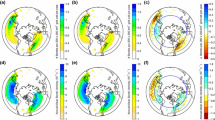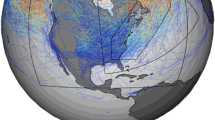Abstract
Extratropical explosive cyclones are rapidly intensifying low pressure systems with severe wind speeds and heavy precipitation, affecting livelihoods and infrastructure primarily in coastal and marine environments. This study evaluates how well the most recent generation of climate models reproduces extratropical explosive cyclones in the Northern Hemisphere for the period 1980–2005. An objective-feature tracking algorithm is used to identify and track cyclones from 25 climate models and three reanalysis products. Model biases are compared to biases in the sea surface temperature (SST) gradient, the polar jet stream, the Eady growth rate, and model resolution. Most models accurately reproduce the spatial distribution of explosive cyclones when compared to reanalysis data (R = 0.94), with high frequencies along the Kuroshio Current and the Gulf Stream. Three quarters of the models however significantly underpredict explosive cyclone frequencies, by a third on average and by two thirds in the worst case. This frequency bias is significantly correlated with jet stream speed in the inter-model spread (R \(\ge\) 0.51), which in the Atlantic is correlated with a negative meridional SST gradient (R = −0.56). The importance of the jet stream versus other variables considered in this study also applies to the interannual variability of explosive cyclone frequency. Furthermore, models with fewer explosive cyclones tend to underpredict the corresponding deepening rates (R \(\ge\) 0.88). A follow-up study will assess the impacts of climate change on explosive cyclones, and evaluate how model biases presented in this study affect the projections.












Similar content being viewed by others
References
Allen JT, Pezza AB, Black MT (2010) Explosive cyclogenesis: a global climatology comparing multiple reanalyses. J Clim 23(24):6468–6484
Anstey JA et al (2013) Multi-model analysis of Northern Hemisphere winter blocking: model biases and the role of resolution. J Geophys Res Atmos 118(10):3956–3971
Arora V, Scinocca J, Boer G, Christian J, Denman K, Flato G, Kharin V, Lee W, Merryfield W (2011) Carbon emission limits required to satisfy future representative concentration pathways of greenhouse gases. Geophys Res Lett 38(5)
Bengtsson L, Hodges KI, Roeckner E (2006) Storm tracks and climate change. J Clim 19(15):3518–3543
Bentsen M et al (2013) The norwegian earth system model, NorESM1-M-Part 1: description and basic evaluation of the physical climate. Geosci Model Dev 6:687–720
Black MT, Pezza AB (2013) A universal, broad-environment energy conversion signature of explosive cyclones. Geophys Res Lett 40(2):452–457
Chang EK (2014) Impacts of background field removal on CMIP5 projected changes in Pacific winter cyclone activity. J Geophys Res Atmos 119(8):4626–4639
Chang EK, Lee S, Swanson KL (2002) Storm track dynamics. J Clim 15(16):2163–2183
Chang EK, Guo Y, Xia X (2012) CMIP5 multimodel ensemble projection of storm track change under global warming, J Geophys Res Atmos (1984–2012), 117(D23)
Charlton-Perez AJ et al (2013) On the lack of stratospheric dynamical variability in low-top versions of the CMIP5 models. J Geophys Res Atmos 118(6):2494–2505
Dee D et al (2011) The ERA-Interim reanalysis: configuration and performance of the data assimilation system. Q J R Meteorol Soc 137(656):553–597
Donner LJ et al (2011) The dynamical core, physical parameterizations, and basic simulation characteristics of the atmospheric component AM3 of the GFDL global coupled model CM3. J Clim 24(13):3484–3519
Dufresne J-L et al (2013) Climate change projections using the IPSL-CM5 earth system model: from CMIP3 to CMIP5. Clim Dyn 40(9–10):2123–2165
Dunne JP et al (2012) GFDL’s ESM2 global coupled climate-carbon earth system models, part I: physical formulation and baseline simulation characteristics. J Clim 25(19):6646–6665
Fink AH, Pohle S, Pinto JG, Knippertz P (2012) Diagnosing the influence of diabatic processes on the explosive deepening of extratropical cyclones. Geophys Res Lett 39(7):1–8
Finnis J, Holland MM, Serreze MC, Cassano JJ (2007) Response of Northern Hemisphere extratropical cyclone activity and associated precipitation to climate change, as represented by the community climate system model. J Geophys Res Biogeosci (2005–2012) 112(G4):1–14
Flato G, Marotzke J, Abiodun B, Braconnot P, Chou SC, Collins W, Cox P, et al. (2013) Evaluation of climate models. In: Climate change 2013: The Physical science basis. Working Group I contribution to the fifth assessment report of the intergovernmental panel on climate change, Tech. rep., Groupe d’experts intergouvernemental sur l’evolution du climat/Intergovernmental Panel on Climate Change-IPCC, C/O World Meteorological Organization, 7bis Avenue de la Paix, CP 2300 CH-1211 Geneva 2 (Switzerland)
Gent PR et al (2011) The community climate system model version 4. J Clim 24(19):4973–4991
Gilhousen DB (1994) The value of NDBC observations during march 1993s “Storm of the century”. Weather Forecast 9(2):255–264
Giorgetta MA et al (2013) Climate and carbon cycle changes from 1850 to 2100 in MPI-ESM simulations for the Coupled Model Intercomparison Project phase 5. Journal of Advances in Modeling Earth Systems 5(3):572–597
Harrell FE (2014) Hmisc: harrell miscellaneous, r package version 3.14-4
Hodges K (1999) Adaptive constraints for feature tracking. Mon Weather Rev 127(6):1362–1373
Hoskins BJ, Valdes PJ (1990) On the existence of storm-tracks. J Atmos Sci 47(15):1854–1864
Kocin PJ, Schumacher PN, Morales RF Jr, Uccellini LW (1995) Overview of the 12–14 March 1993 superstorm. Bull Am Meteorol Soc 76(2):165–182
Lambert SJ (1996), Intense extratropical Northern Hemisphere winter cyclone events: 1899–1991, J Geophys Res Atmos (1984–2012), 101(D16), 21319–21325
Lambert SJ, Fyfe JC (2006) Changes in winter cyclone frequencies and strengths simulated in enhanced greenhouse warming experiments: results from the models participating in the IPCC diagnostic exercise. Clim Dyn 26(7–8):713–728
Li L et al (2013) The flexible global ocean-atmosphere-land system model, grid-point version 2: FGOALS-g2. Adv Atmos Sci 30:543–560
Liberato ML (2014) The 19 January 2013 windstorm over the North Atlantic: large-scale dynamics and impacts on Iberia. Weather Clim Extremes 5:16–28
Lim E-P, Simmonds I (2002) Explosive cyclone development in the Southern Hemisphere and a comparison with Northern Hemisphere events. Mon Weather Rev 130(9):2188–2209
Martin G et al (2011) The HadGEM2 family of met office unified model climate configurations. Geosci Model Dev Discuss 4(2):765–841
McDonald RE (2011) Understanding the impact of climate change on Northern Hemisphere extra-tropical cyclones. Clim dyn 37(7–8):1399–1425
Neu U, Caballero R, Hanley J (2012) IMILAST-a community effort to intercompare extratropical cyclone detection and tracking algorithms: assessing method-related uncertainties, Bulletin of The American Meteorological Society-(BAMS), pp. 529–547
Pinto JG, Zacharias S, Fink AH, Leckebusch GC, Ulbrich U (2009) Factors contributing to the development of extreme North Atlantic cyclones and their relationship with the NAO. Clim Dyn 32(5):711–737
R Core Team (2013) A language and environment for statistical computing. R Foundation for Statistical Computing, Vienna, Austria
Rienecker MM et al (2011) MERRA: NASA’s modern-era retrospective analysis for research and applications. J Clim 24(14):3624–3648
Roebber PJ (1984) Statistical analysis and updated climatology of explosive cyclones. Mon Weather Rev 112(8):1577–1589
Roeckner E, Brokopf R, Esch M, Giorgetta M, Hagemann S, Kornblueh L, Manzini E, Schlese U, Schulzweida U (2006) Sensitivity of simulated climate to horizontal and vertical resolution in the ECHAM5 atmosphere model. J Clim 19(16):3771–3791
Rudeva I, Gulev SK (2007) Climatology of cyclone size characteristics and their changes during the cyclone life cycle. Mon Weather Rev 135(7):2568–2587
Saha S et al (2010) The NCEP climate forecast system reanalysis. Bull Am Meteorol Soc 91(8):1015–1057
Sakamoto T et al (2012) MIROC4h–a new high-resolution atmosphere-ocean coupled general circulation model. J Meteorol Soc Jpn 90(3):325–359
Sanders F, Gyakum JR (1980) Synoptic-dynamic climatology of the “bomb”. Mon Weather Rev 108(10):1589–1606
Stull RB (2000) Meteorology for scientists and engineers: a technical companion book with Ahrens’ Meteorology Today, Brooks/Cole
Taylor KE, Stouffer RJ, Meehl GA (2012) An overview of CMIP5 and the experiment design. Bull Am Meteorol Soc 93(4):485–498
Ulbrich U, Pinto J, Kupfer H, Leckebusch G, Spangehl T, Reyers M (2008) Changing Northern Hemisphere storm tracks in an ensemble of IPCC climate change simulations. J Clim 21(8):1669–1679
Voldoire A et al (2013) The CNRM-CM5. 1 global climate model: description and basic evaluation. Clim Dyn 40(9–10):2091–2121
Volodin E, Dianskii N, Gusev A (2010) Simulating present-day climate with the INMCM4. 0 coupled model of the atmospheric and oceanic general circulations, Izvestiya, Atmospheric and Oceanic. Physics 46(4):414–431
Watanabe S et al (2011) MIROC-ESM: model description and basic results of CMIP5-20c3m experiments. Geosci Model Dev Discuss 4:1063–1128
Xin X, Zhang L, Zhang J, Wu T, Fang Y (2013) Climate change projections over East Asia with \(\text{ BCC }\_\text{ CSM1. }\) 1 climate model under RCP scenarios. J Meteorol Soc Jpn 91(4):413–429
Yukimoto S, Kenkyūjo K (2011) Meteorological Research institute earth system model version 1 (MRI-ESM1): model description. Meteorol Res Inst Tech Rep 64:83
Yukimoto S et al (2012) A new global climate model of the meteorological research institute: MRI-CGCM3 - model description and basic performance. J Meteorol Soc Jpn 90:23–64
Zappa G, Shaffrey LC, Hodges KI (2013a) The ability of CMIP5 models to simulate north atlantic extratropical cyclones*. J Clim 26(15):5379–5396
Zappa G, Shaffrey LC, Hodges KI, Sansom PG, Stephenson DB (2013b) A multimodel assessment of future projections of north atlantic and european extratropical cyclones in the cmip5 climate models*. J Clim 26(16):5846–5862
Zhu X, Sun J, Liu Z, Liu Q, Martin JE (2007) A synoptic analysis of the interannual variability of winter cyclone activity in the Aleutian low region. J Clim 20(8):1523–1538
Acknowledgments
The authors gratefully acknowledge the financial support of the Marine Environmental Observation Prediction and Response Network (MEOPAR) for this research. We thank Dr. Kevin Hodges from the University of Reading (UK) for supporting our application of his cyclone tracking algorithm. We acknowledge the World Climate Research Programme’s Working Group on Coupled Modelling, which is responsible for CMIP, and we thank the climate modeling groups (listed in Table 2 of this paper) for producing and making available their model output. For CMIP the U.S. Department of Energy’s Program for Climate Model Diagnosis and Intercomparison provides coordinating support and led development of software infrastructure in partnership with the Global Organization for Earth System Science Portals. We thank the respective centers for providing their reanalysis data products ERA-Interim, NCEP-CFSR and NASA-MERRA. We are grateful for the constructive comments from two anonymous reviewers. Please contact Christian Seiler (cseiler@uvic.ca) for obtaining the output data presented in this research.
Author information
Authors and Affiliations
Corresponding author
Rights and permissions
About this article
Cite this article
Seiler, C., Zwiers, F.W. How well do CMIP5 climate models reproduce explosive cyclones in the extratropics of the Northern Hemisphere?. Clim Dyn 46, 1241–1256 (2016). https://doi.org/10.1007/s00382-015-2642-x
Received:
Accepted:
Published:
Issue Date:
DOI: https://doi.org/10.1007/s00382-015-2642-x




